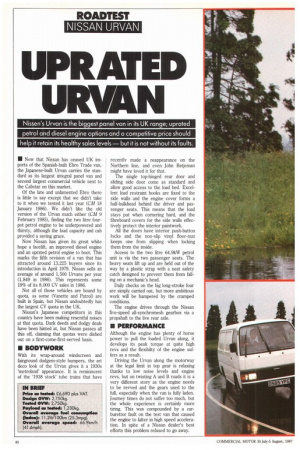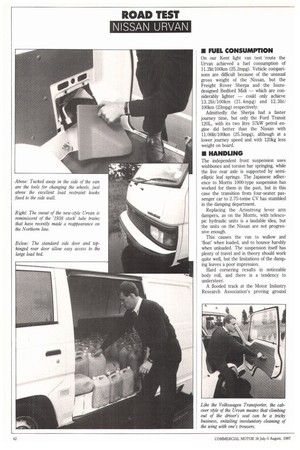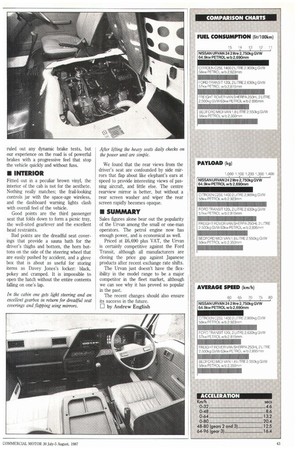UPRATED URYAN
Page 42

Page 44

Page 45

If you've noticed an error in this article please click here to report it so we can fix it.
Nissen's Urvan is the biggest panel van in its UK range; uprated petrol and diesel engine options and a competitive price should help it retain its healthy soles levels — but it is not without its faults.
• Now that Nissan has ceased UK imports of the Spanish-built Ebro Trade van, the Japanese-built Urvan carries the standard as its largest integral panel van and second largest commercial vehicle next to the Cabstar on this market.
Of the late and unlamented Ebro there is little to say except that we didn't take to it when we tested it last year (CM 18 January 1986). We didn't like the old version of the Urvan much either (CM 9 February 1985), finding the two litre fourpot petrol engine to be underpowered and thirsty, although the load capacity and cab provided a saving grace.
Now Nissan has given its great white hope a facelift, an improved diesel engine and an uprated petrol engine to boot. This marks the fifth revision of a van that has attracted around 13,225 buyers since its introduction in April 1979. Nissan sells an average of around 1,500 Urvans per year (1,849 in 1986). This represents some 19% of its 8,000 CV sales in 1986.
Not all of those vehicles are bound by quota, as some (Vanette and Patrol) are built in Spain, but Nissan undoubtedly has the largest CV quota in the UK.
Nissan's Japanese competitors in this country have been making resentful noises at that quota. Dark deeds and dodgy deals have been hinted at, but Nissan passes all this off, claiming that quotas were dished out on a first-come-first-served basis.
• BODYWORK
With its wrap-around windscreen and fairground dodgem-style bumpers, the art deco look of the Urvan gives it a 1930s 'metroland' appearance. It is reminiscent of the '1938 stock tube trains that have recently made a reappearance on the Northern line, and even John Betjernan might have loved it for that.
The single top-hinged rear door and sliding side door come as standard and allow good access to the load bed. Excellent load restraint hooks are fixed to the side walls and the engine cover forms a half-bulkhead behind the driver and passenger seats. This means that the load stays put when cornering hard, and the fibreboard covers for the side walls effectively protect the interior paintwork.
All the doors have interior push-button locks and the non-slip vinyl floor-mat keeps one from slipping when locking them from the inside.
Access to the two litre 64.9kW petrol unit is via the two passenger seats. The heavy seats lift up and are held out of the way by a plastic strap with a neat safety catch designed to prevent them from falling on a mechanic's head.
Daily checks on the big long-stroke four are simply carried out, but more ambitious work will be hampered by the cramped conditions.
The engine drives through the Nissan five-speed all-synchromesh gearbox via a propshaft to the live rear axle.
• PERFORMANCE
Although the engine has plenty of horse power to pull the loaded Urvan along, it develops its peak torque at quite high revs and the flexibilty of the engine suffers as a result.
Driving the Urvan along the motorway at the legal limit in top gear is relaxing thanks to low noise levels and engine revs, but on twisting A and B roads it is a very different story as the engine needs to be revved and the gears used to the full, especially when the van is fully laden. Journey times do not suffer too much, but the whole experience is certainly more tiring. This was compounded by a carburettor fault on the test van that caused the engine to falter in high speed acceleration. In spite of a Nissan dealer's best efforts this problem refused to go away.
• FUEL CONSUMPTION
On our Kent light van test 'route the Urvan achieved a fuel consumption of 11.2lit/100Iun (25.2mpg). Vehicle comparisons are difficult because of the unusual gross weight of the Nissan, but the Freight Rover Sherpa and the Isuzudesigned Bedford Midi — which are considerably lighter — could only achieve 13.21it/100km (21.4mpg) and 12.31it/ 100km (23mpg) respectively.
Admittedly the Sherpa had a faster journey time, but only the Ford Transit 120L, with its two litre 57kW petrol engine did better than the Nissan with 11.061it/100Ian (25.5rnpg), although at a lower journey speed and with 120kg less weight on board.
• HANDLING
The independent front suspension uses wishbones and torsion bar springing, while the live rear axle is supported by semielliptic leaf springs. The Japanese adherence to Morris 1000-type suspension has worked for them in the past, but in this case the transition from four-seater passenger car to 2.75-tonne CV has stumbled in the damping department.
Replacing the Armstrong lever arm dampers, as on the Morris, with telescopic hydraulic units is a laudable idea, but the units on the Nissan are not progressive enough.
This causes the van to wallow and `float' when loaded, and to bounce harshly when unloaded. The suspension itself has plenty of travel and in theory should work quite well, but the limitations of the damping leaves a poor impression.
Hard cornering results in noticeable body roll, and there is a tendency to understeer.
A flooded track at the Motor Industry Research Association's proving ground ruled out any dynamic brake tests, but our experience on the road is of powerful brakes with a progressive feel that stop the vehicle quickly and without fuss.
• INTERIOR
Fitted out in a peculiar brown vinyl, the interior of the cab is not for the aesthete. Nothing really matches; the frail-looking controls jar with the space-age wireless, and the dashboard warning lights clash with overall feel of the vehicle.
Good points are the third passenger seat that folds down to form a picnic tray, the well-sited gearlever and the excellent head restraints.
Bad points are the dreadful seat coverings that provide a sauna bath for the driver's thighs and bottom, the horn buttons on the side of the steering wheel that are easily pushed by accident, and a glove box that is about as useful for storing items as Davey Jones's locker: black, pokey and cramped, It is impossible to open the hatch without the entire contents falling on one's lap.
We found that the rear views from the driver's seat are confounded by side mirrors that flap about Ile elephant's ears at speed to provide interesting views of passing aircraft, and little else. The centre rearview mirror is better, but without a rear screen washer and wiper the rear screen rapidly becomes opaque.
• SUMMARY
Sales figures alone bear out the popularity of the Urvan among the small or one-man operators. The petrol engine now has enough power, and is economical as well.
Priced at £6,690 plus VAT, the Urvan is certainly competitive against the Ford Transit, although all manufacturers are closing the price gap against Japanese products after recent exchange rate shifts.
The Urvan just doesn't have the flexibility in the model range to be a major competitor in the fleet market, although we can see why it has proved so popular in the past.
The recent changes should also ensure its success in the future.
CI by Andrew English




















































































































